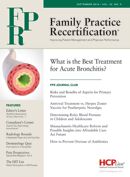Publication
Article
Family Practice Recertification
Risks and Benefits of Aspirin for Primary Prevention
Author(s):
This review article of recently reported systematic reviews demonstrates the cancer risks and benefits of taking aspirin over 5 years, finding a benefit beginning after 3 years of use.

Frank J. Domino, MD
Review
Cuzick, J. et al. “Risks and Benefits of Aspirin for Primary Prevention.” Annals of Oncology 2014; 0:1-10.
This review article of recently reported systematic reviews demonstrates the cancer risks and benefits of taking aspirin over 5 years, finding a benefit beginning after 3 years of use.
Study Methods
This review of recent systematic reviews looked to determine the effect of aspirin on the incidence of site specific cancers and mortality for adults over 10 years starting at age 50.
Results and Outcomes
· Colorectal cancer: There is strong data that even use of low dose aspirin provides a risk reduction in colorectal cancer incidence and mortality. The clearest effect was seen only after 10 years of regular use that was continued through the next 10 years. The benefit was not apparent in the first years of use, especially among women. Based on randomized controlled data the relative risk for the incidence of colorectal cancer was 0.75 (0.56-0.97) and the incidence of colorectal cancer mortality was 0.61 (0.43-0.87).
· Esophageal cancer: Randomized controlled trial data on esophageal cancer was limited and found no significant differences in incidence, but did find a reduction in mortality 0.42 (0.25-0.71). This effect seemed greatest on adenocarcinomas.
· Other gastrointestinal cancers: For stomach cancer, randomized control data was unavailable for incidence, and no significant difference on mortality 0.69 (0.43-1.10).
· Other sites: No strong randomized controlled data was found to determine a benefit of aspirin on other sites including pancreatic, lung, prostate, or breast cancer.
· Aspirin has long been considered of value for cardiovascular disease prevention. Aspirin’s greatest benefit for the prevention of cardiovascular disease occurs in those at moderate to higher risk (RR=0.88 (0.83-0.94) with a NNT = 147-417 (Am J Med 2011 Jul;124(7):621); this benefit was seen primarily in the reduction of non-fatal MI. Despite its benefit on non-fatal MI, there was no reduction seen from aspirin use for primary prevention on cardiovascular mortality (relative risk = 0.94, CI = 0.88-1.00). This came at a cost of an increased risk of hemorrhagic stroke, major bleeds and GI bleeds.
In this study, the influence of aspirin’s bleeding risk found a relative increase of about 33% for hemorrhagic stroke in aspirin users compared to a baseline. The risk for a non-CNS bleeds (primary gastrointestinal) was increased by between 30-70% from overall baseline risk. This risk became significantly more severe in patients at age 70 and older.
Summary
The authors attempted a “best estimate” for individuals using aspirin for primary prevention for over 10 years. What they found there would be a relative reduction of about 9% in men and 7% in women in the incidence of cancer, MI, or stroke over a 15-year period. Absolute reductions were significantly lower. Absolute reductions in cancer, stroke, and MI were approximately 0.95% for women starting at age 50, and 3.84% starting for men at age 65. With this risk reduction came an increased risk of bleeds, most commonly, GI bleeds.
Commentary
Aspirin was once recommended for primary prevention by many organizations. The US Preventive Services Task Force currently recommends aspirin for men ages 45-79 when the potential benefit of MI reduction outweighs the potential harm. They make a similar recommendation for women aged 55-79 for reduction in ischemic stroke when the benefit outweighs the potential for harm. Where that threshold is varies depending upon who makes the recommendation; the table below is the US Preventive Services Task Force recommendation regarding the CV risk level to provide a positive benefit over risk for the use of aspirin to lower cardiovascular endpoints (http://www.ahrq.gov/professionals/clinicians-providers/resources/aspprovider.html).
Favorable Net Benefit from Aspirin Use
Age
10-year MI risk (men)
Age
10-year stroke risk (women)
45-59
≥ 4 %
55-59
≥ 3 %
60-69
≥ 9 %
60-69
≥ 8 %
70-79
≥ 12 %
70-79
≥ 11 %
This article sheds its best light on the benefits of aspirin for the primary prevention of cancers, in particular colorectal and esophageal cancer. There is a clear benefit over risk for the reduction of colorectal cancer. On the other hand, esophageal cancer is relatively uncommon and often related to lifestyle issues including tobacco and alcohol use; thus treating those at greatest risk by adding an aspirin to tobacco and alcohol users seems overly dangerous.
Mortality data for 2014 estimates that lung cancer will continue to be the most likely cause of cancer related death at about 28% for men and 26% for women. Second most common for men is prostate cancer (~10%), and for women is breast cancer (~15 %.) The third most common is colorectal cancer for both men and women; (men 8%, women 9 %.) Esophageal cancer will account for about 4% of cancer related deaths in men and does not make the top 10 for women.
Likewise, for new cancer diagnosis in the United States, the most common cancer for men is likely to remain prostate cancer at 27% and breast cancer for women at 29%. Lung cancer is second most common for both men and women at about 13%, and colorectal cancer about 8% for both men and women.
This study has numerous implications with regard to our ability to counsel patients. Those at moderate to high risk for cardiovascular disease, low dose aspirin (75mg a day) seems to make sense. For low risk patients for cardiovascular disease but higher risk for colorectal cancer, aspirin may provide a benefit over the harm of a gastrointestinal bleed.
The bottom line is aspirin affords a benefit but at a significant risk. Its cancer benefit is primarily in colorectal cancer, and its CV benefit is primarily in a reduction of the risk of non-fatal MI. A 2012 Systematic Review tells us the number needed to treat for the prevention of CV and cancer outcomes is approximately 120, while the risks of a non-trivial bleed provides a number needed to harm of 73 (Arch Intern Med. 2012;172(3):209-216; this article provides a nice pictogram in figure 2). Recommend low dose aspirin only for those at adequate CV risk, and in those who understand the downside.
About the Author
Frank J. Domino, MD, is Professor and Pre-Doctoral Education Director for the Department of Family Medicine and Community Health at the University of Massachusetts Medical School in Worcester, MA. Domino is Editor-in-Chief of the 5-Minute Clinical Consult series (Lippincott Williams & Wilkins).
Additionally, he is Co-Author and Editor of the Epocrates LAB database, and author and editor to the MedPearls smartphone app. He presents nationally for the American Academy of Family Medicine and serves as the Family Physician Representative to the Harvard Medical School’s Continuing Education Committee.



